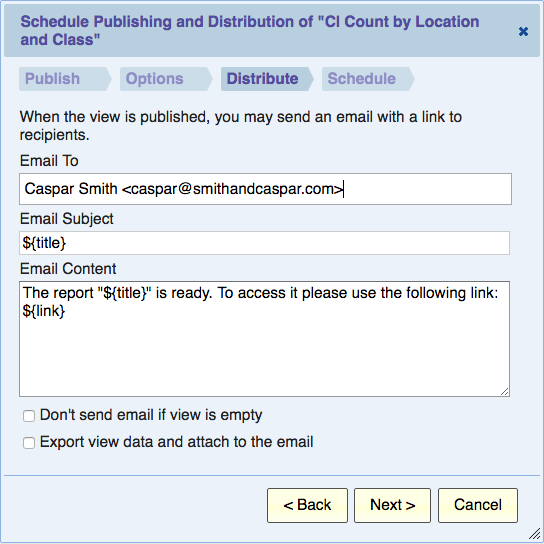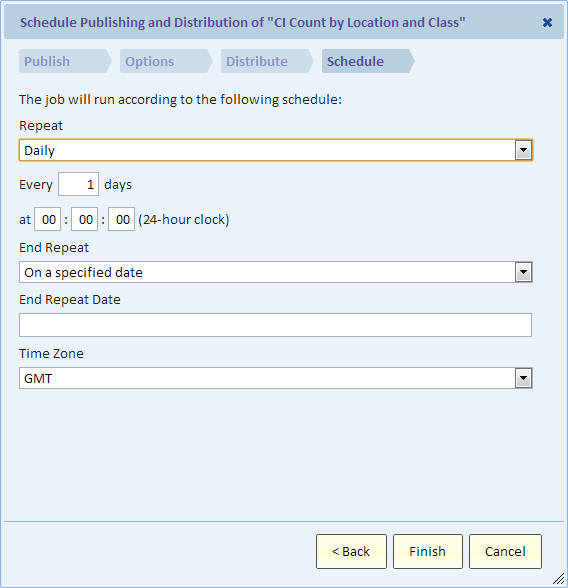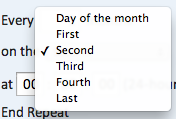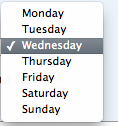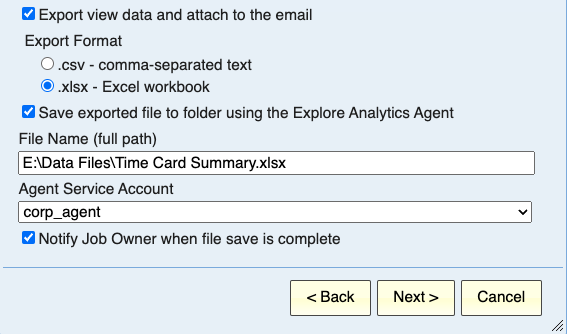Scheduling a View
Contents
Overview
Views can be scheduled to be published and distributed via email on a regular basis. To schedule a view, select "Schedule" from the "File" menu when the view is showing.
Each time a view is published, a new published view is created. When you schedule a view to publish daily, for example, a new published view is created every day. You can list these view using the "Published views" option on the "Views" menu. For live views, you can choose to overwrite the previously published view rather than create another view, for more information on this option see the Publishing page.
The Schedule dialog is a multiple-step dialog. The first few steps are identical to the steps of the Publish dialog. Please see the page Publishing for details.
When scheduling a view, it makes sense to select the "Frozen" option. That way, each time that the scheduled task runs, it creates a new published view that shows the data as of that time.
The last two steps in the multistep dialog are:
- Distribute – specify the email that will be sent each time the scheduled job runs.
- Schedule – specify the recurring schedule for the job. This is similar to scheduling a meeting in a calendar application.
Scheduling views requires the scheduler role, which is included in the tenant_admin role.
Important Note
The view being scheduled will be used each time that the job runs. It means that if the view changes, then subsequent runs would publish the changed view and would reflect that changes. This may be what you intend, but if you don't want any changes to the scheduled job, then it's best to make a copy of the view and schedule using the copy of the view that is not going to be changed.
Distribute
This step defines the email that will be sent each time the job runs. The fields of this dialog are explained below.
You can leave the Email To field empty. No email will be sent, but the view will still be published.
Email To
One or more recipients email addresses. The auto-complete will suggest users within Explore Analytics.
Email Subject
This is the subject line of the email. By default it's the view title, but you can change it. As you can see, we use a special notation to include substitution fields in the subject line. In our example ${title} gets substituted for the actual title.
Email Content
The email content consists of plain text. This is the message content of the email. You can include substitution fields in the message.
Don't send email if view is empty
Select this option to suppress the email if the view contains no rows. This is useful for exception reports if you want to send an email only if there are actual exceptions.
Export view data and attach to the email
This option allows you to distribute a data export of the view in CSV or Excel format. To use this feature, please consider the following:
- This feature requires an Enterprise Plus subscription. If you don't have an Enterprise Plus subscription, you will not see this option.
- The view must be a pivot, chart, or list (mashups ok, but not scorecards or dashboards).
- You must select to publish the view as "Frozen" in the first step of this dialog.
- The exported file will be send as an attachment to the email.
- The view itself will still be generated and you can choose whether to include a link to it in the Email Content.
- Data export allows more data than the displayed view, but is still subject to the data export limit and the job will fail if that limit is exceeded.
- For CSV files, the character-set is based on the default established when you export view data from the file menu. the default is UTF-8, so if you need a different encoding, please set the default by exporting data manually once and selecting a new default.
Using Substitution Fields in the Email
Some of the options noted above provide the ability to include substitution fields. You can insert items from the following list in the text of the subject or the content of your email.
All substitution fields are in the format ${field}. These variables will auto-populate with the appropriate value at the time that the report is issued. Variables available are:
- ${title} - The view title. If used in the Title option, the variable will be blank.
- ${subtitle} - The view subtitle. (Note: displaying totals here is limited to frozen views only)
- ${date} - The date at the time the view is published (the job run).
- ${date:<format>} - The date at the time the view is issued, where you specify the format of the date and time according to the Java format.
- For example, ${date:MM/dd/yyyy HH:mm} would render as 12/06/2014 17:46.
- ${link} - The URL link to the published view.
Recipients may opt out
You should review your email distribution from time to time because over time the relevance of this report to the recipient may change as their job responsibility changes.
At some point, a recipient may prefer not to receive the report anymore. In that case they can reply to the email and ask you to remove them from the distribution, or they can use a link at the bottom of the email to opt out of receiving this report. They can use the same link to opt back in.
Schedule
The last step is to specify the schedule.
Repeat
The regularity of report distribution. Options are:
- Daily
- Weekly
- Monthly
Every
Every ___ Days/Weeks/Months - The number of days, weeks, or months between distributions (depending on the value of Repeat).
Day (if weekly)
If weekly, select the check-boxes for the days of the week that the report will be sent on. For example, the following indicates a report that will be sent Monday, Wednesday, and Friday:
Day (if monthly)
If monthly, select the drop-downs that correspond to the day of the month that the report will be sent on:
At
Time of day that the report will be send on (on the days indicated above) according to the twenty four hour clock (between 00:00:00 and 23:59:59).
End Repeat
Determines if there is an end to the regular report scheduling. Choices are:
- Never - The report will continue indefinitely. Users with access to My Scheduled Jobs can remove these jobs at a later time.
- On A Specified Date - The report will continue until a date selected in the field below.
End Repeat Date
If On A Specified Date is selected, select the date using the date picker that the report will cease being emailed.
Time Zone
The timezone to use for all of the dates and times selected above.
Saving Data File to a Folder
It is possible to schedule a view to run and export its data and then save the data as a file to a folder in your environment. This option has two requirements:
- Select Export view data and attach to the email.
- You must have an Explore Analytics Agent installed.
File Name (full path)
Please specify the full folder path including the file name and extension. The folder must be accessible from the agent and have write permission granted to the agent account (the operating-system user account under which the agent is running).
Agent Service Account
If you have more than one agent, select the agent that will be used for saving the file.
Notify Job Owner when file save is complete
When checked, an email will be sent to the user who created the scheduled job to let them know that the file is saved and ready (or that there was a problem). If the job is shared, an email is sent to all the Explore Analytics admins for your organization.
Listing Scheduled Jobs
Once jobs are scheduled, you can navigate to Admin > Scheduled jobs to see a list of previously scheduled jobs:
The columns of the scheduled jobs correspond to the options selected above. The Error column will contain an error message if the scheduled job failed on its most recent execution.
You can share a job by selecting "Share job" from the context menu. When you share the job, the view on which it is based will be shared as well. Other people on your team that have the scheduler role will be able to see this job, run it and edit it.
You can "Un-share" a shared job. That will make the job and its view "personal" again and only visible to you.
